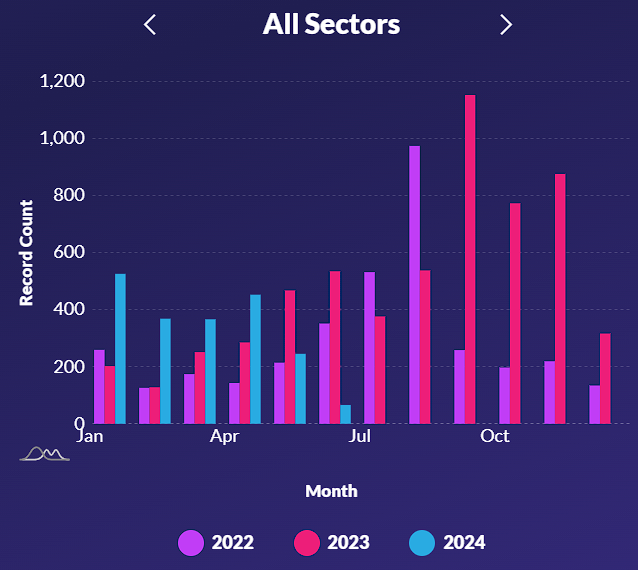Exclusive: Galxe CEO Harry Zhang on Digital Identity, AI Trading Insights, and the Launch of Gravity L1
In a recent interview at Consensus 2024 in Austin, Texas, Rachel from Cryptonews sat down with Harry Zhang, the CEO and co-founder of Galxe, to discuss his company’s latest advancements and offerings. This conversation covered various aspects, including the significance of digital identity in Web3, the role of AI in trading, and the launch of Galxe’s Gravity L1 blockchain. Here are the key takeaways from their insightful discussion:
Galxe, formerly Project Galaxy, operates on the Galxe Identity Protocol. It is positioned as the largest on-chain distribution platform and aspires to become a decentralized super app that facilitates user navigation in the Web3 space.
With over 20 million users and 5,000+ projects utilizing its platform daily, Galxe recently launched its own Layer 1 blockchain, Gravity.
“We started off as Galxe Quest and the underlying Galxe identity protocol which powers the quest,” Zhang said. “Right now, we are the largest on-chain distribution platform and we’re aiming to become this decentralized super app by helping users to navigate everything in Web3.”
Digital Identity Key to Galxe’s Questing Platform
Digital identity is a core focus for Galxe. Initially built upon the digital identity network, their questing platform integrates this to verify user activities and task completion.
Zhang elaborated on how the identity protocol aggregates user credentials from both on-chain and off-chain sources, such as holding NFTs or social media interactions. This aggregation helps projects track contributions and reward users with airdrops, NFTs, and tokens.
“Quest is basically built upon the digital identity network,” he explained. “In order for us to check the user activities or whether a user completed different tasks in a quest, we have this credential network that curates data from different channels online.”
Zhang further emphasized the critical role of digital identity in the Web3 ecosystem. Unlike Web2, where information is siloed across multiple platforms, Web3 aims to centralize user information securely and privately.
Galxe Passport, a key solution in this area, allows users to verify their identity and share encrypted information with third parties, enhancing security and privacy through zero-knowledge proofs.
“Our identity protocol provides a way for users to aggregate their information everywhere so there’s no information silo about you,” Zhang noted. “You can also choose to share your information with other third parties securely and privately.”
Digital identity in the Web3 space addresses major issues faced in the Web2 world, where identity theft and data breaches are prevalent. According to the Identity Theft Resource Center, data breaches in the U.S. exposed over 1.1 billion personal records in 2020 alone.

In contrast, using blockchain technology in Web3 can greatly reduce such risks by ensuring data immutability and enhancing privacy.
Galxe Enhances Web3 with AI-Driven Trading and Investing
Galxe’s commitment to enhancing the Web3 experience extends to trading and investing through AI. Their AI agent compiles high-quality, real-time data from social media, on-chain transactions, centralized exchanges, and macroeconomic indicators.
This data feeds into their Alva LLM model, providing users with trading insights, signals, fundamental analysis, and social trends, helping them make informed decisions.
According to a recent report by PwC, integrating AI in financial services could generate up to $2 trillion in value annually by enhancing efficiency and providing better insights.
The use of AI in trading has been growing, with the global algorithmic trading market projected to reach $18.8 billion by 2026, highlighting the increasing reliance on sophisticated models like Alva to make better financial decisions.
“AI is the part where we want to help users to do better trading and investing and research in the Web3 world,” Zhang explained. “Alva compiles information with high-quality curated real-time data from social media platforms, on-chain data, and centralized exchanges.”
AI’s role in trading is transformative. For instance, hedge funds using AI-driven strategies have outperformed traditional ones. According to Eurekahedge, AI, and machine learning, hedge funds delivered a cumulative return of 32% from 2016 to 2021, compared to 12% for the average hedge fund.
Galxe Announces Gravity: A Layer 1 Blockchain to Address Chain Fragmentation and Enhance User Experience
One of the most exciting announcements from the interview was the upcoming launch of Gravity, Galxe’s Layer 1 blockchain. Gravity seeks to solve the challenges of chain fragmentation and user experience by connecting various blockchains and abstracting away complex interactions.
“The Gravity Alpha mainnet is going to be launched in two weeks, and we’re very excited about it,” Zhang announced. “Gravity really aims to become this layer one blockchain designed for mass adoption and connects all the chains out there.”
Layer 1 blockchains, such as Ethereum and Solana, have grown substantially. Ethereum alone processes over 1 million transactions daily and secures billions in value across decentralized applications.
1/ Welcome to the decentralized future of @Galxe. Introducing Gravity, the Layer-1 blockchain designed for mass adoption and an omnichain future.https://t.co/4V50QteCEO pic.twitter.com/iLJdWQoB3L
— Gravity (@GravityChain) May 29, 2024
Zhang noted that while they are introducing another Layer 1 blockchain, the goal is not to compete with established platforms like Ethereum or Solana but to enhance interoperability and user experience in the Web3 space.
Interoperability is a critical focus, as it could unlock new possibilities for decentralized finance and beyond. Given the current state of crypto, Gravity seeks to tap into this emerging market by focusing on interoperability and user experience, offering enhanced connectivity and usability.
Layer 1 blockchains play a key role in the cryptocurrency ecosystem. For example, in 2023, Ethereum had over 3,000 decentralized applications (dApps) running on its network, with a total value locked (TVL) of over $70 billion in its DeFi protocols.
Consensus 2024
Cryptonews reporters Rachel Wolfson and Matt Zahab were on the ground at Consensus 2024. Taking interviews from industry leaders and pioneers, as well as prominent analysts, they bring you the latest updates from one of the biggest crypto events globally.








